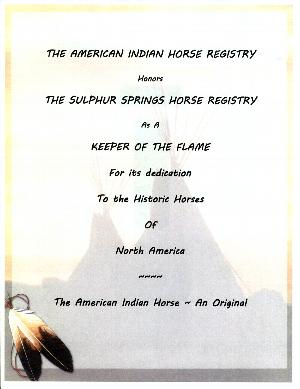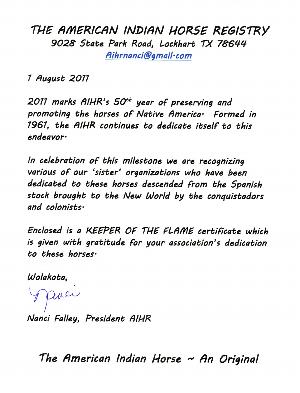Because of all of the hard work and dedication of the BLM, these wonderful Sulphur horses are able to survive out there on the Sulphur Springs Herd Management Area. We would like to thank them and offer our help whenever possible.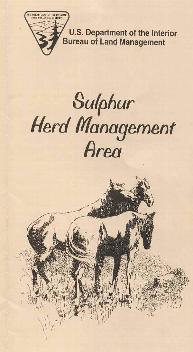
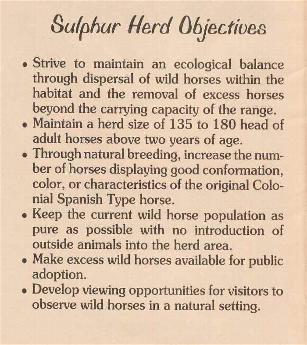
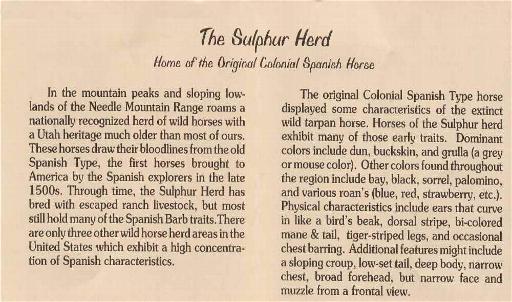
The 1978 revision to the The Wild Free Roaming Horse and Burro Act (WFRHB Act) stated that: "For the purpose of furthering knowledge of wild horse and burro population dynamics and their interrelationship with wildlife, forage and water resources, and assisting him in making his determination as to what constitutes excess animals, the Secretary shall contract for a research study of such animals with such individuals independent of Federal and State government as may be recommended by the National Academy of Sciences for having scientific expertise and special knowledge of wild horse and burro protection, wildlife management and animal husbandry as related to range land management. The terms and outline of such research study shall be determined by a redesign panel to be appointed by the President of the National Academy of Sciences. Such study shall be completed and submitted by the Secretary to the Senate and House of Representatives on or before January 1, 1983." The result of the Congressionally mandated research study was that the BLM designated Herd Management AreasHMA’s for the purpose of managing wild horse populations that existed at the time the WFRHB Act was passed in 1971. One of those was the Sulphur Springs HMA, eloquently described by Ron Roubidoux in his essay; WILD HORSES OF UTAH'S MOUNTAIN HOME RANGE.
"The Mountain Home Range lies at the north end of the Bureau of Land Management's Sulphur Herd Management Area, which is located in southwestern Utah. Craig Egerton, Supervisory Range Conservationist for the BLM's Beaver River Resource Area, says that most maps show the entire north and south running range as the Needle Range, but local people break it up into the Mountain Home Range on the north and the Indian Peak Range on the south. The highest elevation in the Mountain Home Range is 9,480 feet whereas Indian Peak has an elevation of 9,790 feet. The forty-mile long Needle Range is covered with heavy stands of pinion and juniper, and is located east of the Nevada-Utah border. Hamblin Valley is on the west, Pine Valley is on the east, and the Escalante Desert is on the south. Antelope Valley, the Burbank Hills, and Great Basin National Park are on the north. "Elevations of the surrounding valley floors are between 5,000 and 6,000 feet. From the dry, lifeless hardpan of the valley floors the land gently rises over native grass covered flats to sagebrush covered benches, and finally to the pinion-juniper covered mountains. Benches and mountains are broken up with many rugged canyons and draws. Low areas are generally sandy while the mountain slopes are very rocky. The Sulphur Herd Management Area is approximately 142,800 acres, and covers the entire Needle Range. Most of the area is unfenced. Gus Warr, Range Conservationist for the BLM's Beaver River Resource Area, says there is an imaginary line between Vance Spring and Sulphur Spring which divides and separates the horses in the Sulphur Herd Management Area. The area between these springs also divides the Mountain Home Range from the Indian Peak Range. Both Craig and Gus have said that most of the Spanish type horses are found north of this line on the Mountain Home Range. The BLM is therefore managing this area specifically for the Spanish type horse. The herd management area gets its name from the Sulphur Springs. There are three springs in all, North Sulphur Spring, South Sulphur Spring, and Sulphur Spring. Many other springs are found throughout the Needle Range."There has been a lot of discussion about the horses on either side of this so-called "Line". In the early '90's, about 45 horses were gathered south of this line, that were identical to those found north of it. Barb, Mestene, Takita, and possibly some others were accepted into the Spanish Mustang Registry – SMR and they came from the south side of this line. The line should be drawn several miles south of where it is estimated to be, probably from the crooked fence indicated on the map, extending southeast through the middle of Green's Canyon to the Indian Peak Game Management Area. The 1978 revision of the WFRHB Act also allowed for the adoption of excess animals by the public. Before placing horses for adoption, the BLM freeze brands them, which allows for captured Sulphur horses to be identified. The BLM has a webpage explaining how to read the freeze brands, the third and fourth digits of which identify the BLM district where the horse was captured. For the Cedar City district, which administers the Sulphur Springs HMA, those digits are "7" and "4". The Cedar City district has 10 herds, whose locations can be seen on the map.
Utah Wild Horse Herd Management Areas Sulphur Herd Management Area Contact: Cedar City Field Office 176 E. D.L. Sargent Drive Cedar City, UT 84720 (435) 586-2401
The Sulphur Herd roams a vast, unpopulated region of alternating high desert basins and expansive mountain ranges. Their home, the Needle Range, is a starkly beautiful mountain block that lies about 50 miles west of Milford, Utah along the Utah-Nevada border. In some spots, the range rises to nearly 10,000 feet in elevation. from north to south, the mountainous spine of the Needle Range is comprised of two main peaks--Mountain Home and Indian Peaks.
In the mountain peaks and sloping lowlands of the Needle Mountain Range roams a nationally recognized herd of wild horses with a Utah heritage much older than most of ours. These horses draw their bloodlines from the old Spanish Type, the first horses brought to America by the Spanish explorers in the late 1500s. Through time, the Sulphur Herd has bred with escaped ranch livestock, but most still hold many of the Spanish Barb traits. There are only three other wild horse herd areas in the United States which exhibit a high concentration of Spanish characteristics.
The original Colonial Spanish Type horse displayed some characteristics of the extinct wild tarpan horse. Horses of the Sulphur herd exhibit many of those early traits.
Dominant colors include dun, buckskin, and grulla (a grey or mouse color). Other colors found throughout the region include bay, black, sorrel, palomino, and various roan's (blue, red, strawberry, etc.). Physical characteristics include ears that curve in like a bird's beak, dorsal stripe, bi-colored mane and tail, tiger-striped legs, and occasional chest barring. Additional features might include a sloping croup, low-set tail, deep body, narrow chest, broad forehead, but narrow face and muzzle from a frontal view.
Sulphur Herd Objectives
Strive to maintain an ecological balance through dispersal of wild horses within the habitat and the removal of excess horses beyond the carrying capacity of the range.
Make excess wild horses available for public adoption
Maintain a herd size of 135 to 180 head of adult horses above two years of age.
Through natural breeding, increase the number of horses displaying good conformation, color, or characteristics of the original Colonial Spanish Type horse.
Keep the current wild horse population as pure as possible with no introduction of outside animals into the herd area..
Develop viewing opportunities visitors to observe wild horses in a natural setting.
We Need Your Help
We invite you to view wild horses, however it is unlawful to chase and/or catch them. Foals, pregnant mares and older horses are easily hurt when pursued, so please allow them to live a free and unharassed life.
Help our wild horses by reporting illegal activity. Contact your BLM office or call BLM Law Enforcement at (801) 539-4286.
Best Opportunity for Viewing
The Needle Range is characterized by steep slopes and narrow ridges. Access to the ridges and surrounding area is good, provided you are driving a vehicle capable of traversing rough, back country roads.
You will find most of the horses in the Mountain Home portion of the range. An extensive dirt-road system provides access throughout the entire area for those properly equipped. Typically, roads wander through sagebrush flats and forests of pinyon and juniper. The high country of Mountain Home Peak is a particularly pleasant destination, providing outstanding views of Hamlin Valley and Great Basin National Park.
The best access to the road network within the herd area is Utah Highway 21. Approximately 45 miles west of Milford on LI-21 look for a BLM sign marked Pots Sum Pa. Turn south on this road to enter the northeastern portion of the Sulphur Herd Management Area.
A Few Viewing Tips
Look in certain areas. Scan reseeding project and prescribed burns where forage is plentiful.
Look for wild horses from high elevations. Mountain Home Peak provides an excellent vantage point to look for wild horses.
Adapt your viewing strategy to the time of year you visit. Horses migrate to higher elevations during the warm summer months. In late fall and spring they can be found on the benches of Hamlin and Pine Valleys.
Take binoculars. Wild horses are naturally wary and best viewed at a distance. When approached, they will spook and run for cover.
Special Travel Conditions
Take along a good map. Detailed topographic maps provide the best information about roads and topographic features in this area. The extensive road system in this area can be difficult to decipher unless you have a good map and the ability to navigate with it.
Four-wheel drive and high clearance vehicles are recommended. Seasonal rains and snow will make the road in the management area muddy, slick, rutted, and impassable.
Come prepared. Make certain that you and your vehicle are properly equipped for a back country adventure. Adequate gasoline, extra water, tire chains, tools to make repairs, a first aid kit, and making sure that someone at home knows where you are and when your are expected back are just a few of the basic precautions you should take whenever traveling in a remote area.
BLM Herd Management Areas
In 1971, Congress passed legislation to protect, manage, and control wild horses and burros on the public lands. The Wild Free-Roaming Horse and Burro Act declared these animals to be "living symbols of the historic and pioneer spirit of the West."
Congress further declared that "wild free-roaming horses and burros shall be protected from capture, branding, harassment, or death..." and that they are "...an integral part of the natural system of the public lands." Furthermore, Bureau regulation requires that wild horses and burros be considered comparably with other resource values within the area.
The Bureau of Land Management maintains and manages wild horses or burros in "herd management areas" (HMAs).
In the ten states where BLM manages horses, there are 270 herd areas. In Utah, about 3,600 horses are found among 23 different herds scattered across the state. Two herds of burros containing about 100 animals are found on public lands in southeastern Utah.
Management Objectives
A management objective for the herd area is to ensure proper utilization of the area by wild horses at a level sufficient to guarantee their continued existence without exceeding the overall carrying capacity for all animals--livestock, wildlife and horses.
Another objective is to develop a recreation and viewing area for the public to observe wild horses in a natural setting.
Contact: Gus Warr Gus_Warr@blm.gov (801) 539-4057 Bureau of Land Management Utah State Office PO Box 45155 Salt Lake City, Utah 84145-0155 Phone: (801) 539-4001 Fax: (801) 539-4013
Printable version of the above BLM document with viewing tips
Thanks to Gus Warr for the following information on the early years of the Sulphur HMA: Early BLM History, 1971-1989
1971-80: Horses were inventoried and monitored with no removals ever taken place during this period.
1980: The first authorized removal of any horses took place from the Sulphur HMA, 19 horses were captured and adopted out locally.
1985-86: 78 horses were removed from the HMA, and BLM managers began to take notice of the unique characteristics of the Sulphur HMA. Many of those were returned to the HMA because BLM realized that they were something very special. I (Gus) remember seeing a photo of the returned animals, and they were all a bunch heavily marked-up line back duns with strong Spanish characteristics.
1987: The Sulphur Herd Management Area Plan was signed February 1987. Specific objectives were put into place including the objective to: "Increase the occurrence of animals with good conformation and those displaying the characteristics of the wild Tarpan type of horse and those with colors that occur less frequently to increase the adoptability of horses removed for management purposes."
1988-89: 78 horses were captured and adopted to individuals across the state of Utah. This seemed to spark an interest by a number of private individuals regarding the uniqueness of these horses.
The rest of this information came from BLM records.
July 1990- 740300, Delta, had previously been captured and released in 1985. She was recaptured at this time, making 25 horses total gathered at various sites on the Mountain Home Range. Three of these - two dun stallions and a dun mare were released to the Conger HMA, two were sent to a sanctuary, and the rest were adopted out. Three of those, including Delta, were taken to Oregon, where they were inspected for registration in the Kiger Mesteno Association (KMA). Nine of the 25 horses captured, including those released to Conger were blood typed. Delta was mtDNA tested, and found to have the "D1" pattern.
August 1990- 7 horses likely gathered from the south end of the Sulphur Springs HMA. All the horses captured in 1990 were caught by running and roping, so it is difficult to ascertain where they were caught. There was a serious accident during the roundup, in which one of the ropers accidentally roped another rider around the neck, and jerked him off his horse. Fortunately, the rider survived.
August 1991-Ten horses captured on the HMA.
March 1992-several horses gathered up on the Sulphur Springs HMA. One of the horses being a dun mare, Sulphurs Checshawni Dream SHR#SS1168M owned by Outlaw Ranch. July 1992-10 horses, including Mestene SHR #SS1023M gathered at a trap several miles south of Cougar Spring, but further research indicates the trap was on the Speers re-seed, several miles to the northwest of the actual peak and placed for adoption. These horses were water trapped one of them, 596 or the "Blue Stallion", was released into the Conger HMA.July 1992-17 horses (including Takita) illegally gathered during a weekend from the trap site at the Speers re-seed. They were recovered, two were released into Mountain Home, three died, and the others were eventually placed for adoption. As part of the investigation of the attempted theft of these horses, blood samples were drawn from them as well as from the other horses captured at that trap and were sent to Gus Cothran for comparison between the two groups. Takita, Barb and Mestene were later mtDNA tested, and found to have the "D1" pattern.
August 1992-36 horses (including Cortez, Lancelot, Spice, Tia (deceased) and Smokey; all of which were blood typed after adoption, and all of which but Lancelot were mtDNA tested, and found to have the "D3" pattern, gathered from Cougar Spring and placed for adoption. (Upon further research, it appears that about 1/4 of these horses were the ones captured further south, in Green Canyon, a few miles northwest of Indian Peak. Gale Bennett stated that the horses from Green Canyon were identical to the ones gathered further northwest. The horses from Cougar Spring and Green Canyon were mixed together when processed, so it's impossible to know which came from where, although he does remember that Cortez came from Cougar Spring).
January 1993-48 horses (including Diamond D Madrina [blood typed after adoption] and Colorado's Lady Hawk, both of which are SMR registered and also Sundance) gathered at a trap(s) on Mountain Home. One, a chestnut mare, was released to the Swasey HMA. She was recaptured in 2003, and sent to a sanctuary.
March 1993-69 horses -including Diamond D LaGrima (Annie), Chance SHR #SS1024S and Spanish Lady, who were blood typed after adoption Chance and Spanish Lady were also mtDNA tested, and found to have the "D1" pattern, and Sampson SHR #SS1003S (deceased) and Blossom SHR #SS1006M (owned by KW Mustang Ranch) caught at Pot Sum Pah in the Southeast quadrant of Mountain Home.
Four of the unadopted horses were released back to Mountain Home.
April 1993-three foals born in captivity.
In August 1993, the BLM paid Dr. Phil Sponenberg's expenses to visit Utah and evaluate the Sulphur horses. Here is his report;
D.P. Sponenberg DVM, PhD
EVALUATION OF SULPHUR HERD MANAGEMENT AREA BLM HORSES - AUGUST, 1993
D. P. Sponenberg, DVM, PhD, Veterinary College, VPI, Blacksburg, VA 24061 703-231-7666
SUMMARY: The Sulphur Herd Management area horses that are present as adopted horses in the Salt Lake City area appear to be of Spanish phenotype. The horses were reasonably uniform in phenotype, and most of the variation encountered could be explained by a Spanish origin of the population. That, coupled with the remoteness of the range and blood typing studies, suggests that these horses are indeed Spanish. As such they are an unique genetic resource, and should be managed to perpetuate this uniqueness. A variety of colors occurs in the herds, which needs to be maintained. Initial culling in favor of Spanish phenotype should be accomplished, and a long term plan for population numbers and culling strategies should be formulated. This is one population that should be kept free of introductions from other herd management areas, as it is Spanish in type and therefore more unique than horses of most other BLM management areas.
BACKGROUND: Detailed historical background of the Sulphur herd management area horses is not available. The limited amount of history available points to this population being an old one, with limited or no introduction of outside horses since establishment of the population. The foundation of the herd is logically assumed to be Spanish, since this the only resource available at the time of foundation. Spanish type includes sloping croup low set tail, deep body, narrow chest, deep Roman nosed head from side view, broad forehead but narrow face and muzzle from front view, eyes place on side of head, small ears with inwardly hooked tips, small or absent rear chestnuts, small front chestnuts, potential of long hairs on stern area and chin. All colors are possible, although a high proportion of black and its derivatives are consistent with a Spanish origin. Line backed duns, roans, buckskin/palomino, sabino and overo paint, and the leopard complex are also usually Spanish in origin, and grey and tobiano can be. It is frequently the mix of colors and their relative frequency in the population that is more important than the presence of absence of any one color.
PRESENT STATUS: The horses removed during the last few years from the Sulphur Herd management area are Spanish in type. Thirty four horses were inspected during my visit. Of these 10 were of excellent Spanish type, 10 were of good Spanish type, and 10 were only moderately Spanish in type (although some of these were excellent, if nonSpanish, horses), and four were clearly different from-generally acceptable Spanish type. The fact that the horses were so consistently Spanish type is evidence that these horses have a Spanish origin. Most of the inspected horses fit into the Spanish description. Those that deviated from it tended to have wider fronts than desire and somewhat broader or coarse heads. Roman noses were not prominent, though, and so some of these "atypical" animals still had very acceptable conformation as horses, but lacked the typical Spanish appearance desired. Some ears were long, and some lacked, the inward hooking tips. Chestnuts were usually moderate and not small; some were large. Black and grullo were common, with bay and zebra dun common as well. Chestnut and red dun were also present, but less common. This is consistent with a Spanish origin,
although it would be interesting to determine if other colors occur in other parts of the range. Gus Cothran has blood typed a small number of these horses, and is struck by the frequency of antigens known to be of Spanish origin. While further sampling would be useful, he is confident that this population will ultimately prove to be one of the more consistently Spanish of feral populations so far studied.
RECOMMENDATIONS: The Sulphur herd management area horses are generally Spanish in type, and should be managed to enhance this characteristic. Other populations of feral horses that are Spanish in origin are very rare (Pryor Mountain MT, Marble Canyon AZ, and Kiger OR, although these last are varying from Spanish phenotype more than the others). Since the Spanish feral horses are the only feral horses of truly unique and irreplaceable genotypes, they should be manager as a genetic resource in addition to other BLM requirements. In the case of the Sulphur herd I recommend that target population levels be set that are consistent with this population being able to sustain itself without needing introductions of outside, non-Sulphur, horses. This maintenance would assure its continuation as an unique herd of Spanish horses. I also recommend that for the next several years the removal/adoption process concentrate on removal of the least typically Spanish and retention of the most typically Spanish horses. This process may be difficult for a few years, with removal of some older animals. It must be stressed that the broad front is not typically Spanish, while the deep body with narrow chest is. Following the first few years the removals should only have to involve younger animals that are of less Spanish appearance. The long term management should quickly develop into the removal of younger animals that are surplus to the population, but these should all be of Spanish type as the population becomes more uniform for this type. Given the remarkable uniformity of the population already, this process should not take very long. The Sulphur herd is minimally variable for color, and this variation should be maintained. I only saw bay, black, chestnut and the line-backed modifications of these (zebra dun, grullo, and red dun). I suspect that on some portions of the range other colors persist since they are mentioned in the herd management plan. It is important to not cull these. The preference for the line-backed colors is based on myth, and these colors do not imply that the horses are more Spanish than those lacking these colors. The same is true of the white marks: they are perfectly allowable. While the appeal of the line-backed colors is undeniable, the other colors should be maintained at levels that prevent their extinction.
The Sulphur Herd Management Area brochure is good and informative, but I would recommend a few changes. First, late additions to the herd are only speculative, and since the herd is so consistently Spanish in type I would concentrate on that. Also, I would point out that various colors (not just the line- backed ones) are consistent with a Spanish origin. I like the stripes, but they can be overemphasized to the point that people equate them with Spanishness, which is inaccurate. Another technicality is that there really is no such thing as a "Spanish Barb". The Spanish Colonial type horse is the foundation of these mustangs. The Barb is a North African horse, descended originally from Iberian horses. Finally, some conformational details on the drawing could be more Spanish (narrower front, finer face/muzzle, sloping croup). These points are picky, but the brochures do a great job of educating, and accurate details will help in the education process even more.
LIST OF SULPHUR MANAGEMENT HORSES INSPECTED, August, 1993 by Sponenberg and Roubidoux. Excellent = top third, Good = middle third. Horses listed in the order in which they were seen, check with Ron for names of owners.
First stop.- dun filly: good; grulla filly: somewhat coarse, bottom third; chestnut filly: good, but has big chestnuts; black foal: good, difficult to be certain due to age.
Trujillo stallion - bottom third. Roached back, head somewhat coarse. bay gelding - not typical. grulla gelding - good, well conformed and Spanish in appearance. grulla mare and foal - good, typical
red dun Jones mare - excellent in type.
grulla Torres filly - excellent, finely made, Front is good. grulla foal - good to excellent, depending on how facial width develops. chestnut mare - very wild, appears to be in bottom third. Large chestnuts.
Jensen dun stallion - good, head lacks definition (as I remember)
One stop, (I forget the guy's name): black colt: bottom third, largely due to broad face; sorrel filly: somewhat better than colt; but still bottom third; bay stallion: excellent, the best roman profile, and a very assured, classy animal. He is one of the best overall animals.
Grant - grullo stallion: common head, bottom third. Lack of stallion attitude.
Duce animals - dun stallion: bottom third, wide front; grullo stallion: good, but head could be more typical; dun filly: excellent, very typical; black filly: good.
Steve Hart animals - red dun gelding: bottom third, high croup; black colt: excellent, very typical; grullo colt: excellent, very typical.
Rhonda - bay female, bottom third (wide front, the most common fault); red dun female, bottom third; red dun stallion, too wild to evaluate;
Roubidoux - dun stallion (background horse; photo by Ron Roubidoux): stocky, but excellent; grulla mare: excellent; grulla filly: excellent; grulla foal (filly): excellent; bay mare: poor, large, wide, and wide faced; dun older filly from bay dam: bottom third or lower; younger filly from bay dam: better, but still bottom third.
OVERALL: These horses cluster very nicely as a Spanish type population. They are generally soundly conformed, in addition to the Spanish type. The most common of the deviations from Spanish type are the wide fronts, wide facial areas, long ears, and large chestnuts. These horses that are not typically Spanish are still well conformed on average. This should make them very adoptable and serviceable. Basically, even the non-Spanish horses in the group are good horses, just of the non-Spanish type. _______________________________________________________________________________
December 1993-nine horses - 740292, had previously been captured and released in 1985. She was recaptured at this time, making nine horses total. (She was adopted by a Sulphur breeder) caught southeast of Vance Springs. All but 740292 were blood typed. One of these, a dun stallion, was released to Conger and four others were released in Mountain Home.
February 1994-three horses caught on "state land re-seed east of the Speers Ranch", (this should not be confused with "Speers re-seed" trap site the 1992 horses were captured at. The Speers Ranch is in Nevada, about due west of Indian Peak) to prevent them from trespassing on the state-owned lands. All three were blood typed; and a dun stallion was released to the Chloride herd.
February 1994-two more mares caught at the January trap-site southeast of Vance Springs. Both were blood typed; one was adopted by an early Sulphur breeder.
March, 1994-Ron Roubidoux writes Wild Horses of Utah's Mountain Home Range. At the time, Spanish Mustang Registry (SMR) inspectors would travel to inspect horses for inclusion in the registry (a year or two later, the SMR changed its bylaws and mandated that horses be brought to the registry's annual meeting to be inspected), so two months later representatives of the SMR came to Utah, inspected 20 Sulphur Horses, and accepted 17 of them into the registry.
In June, 1995, representatives of the SMR visited Rexburg, Idaho, and accepted 12 horses into the registry, including Chief Wakara SHR #SS1048S, Sampson SHR#SS1003S (deceased) also Blossom SHR #SS1006M, Tafel SHR #SS1013M and Strawberry SHR #SS1004M all 3 owned by KW Mustang Ranch. Unfortunately, only Chief Wakara was actually registered. Early in 1997, most of these horses were leased to the Blackfeet Buffalo Horse Coalition.
September 1996-148 horses, including RIO SHR #SS1095G, Cisco SHR #SS1061M, Mere SHR #SS1030M, LaBlanca SHR #SS1060M, Chulito Ballo SHR #SS1082M, Sulphur's Prince SHR #SS1091S owned by Judy Cubel and Senior Diego SHR #SS1085S, Sulphurs Majesty SHR #SS1170M owned by the Outlaw Ranch (deceased) captured on Mountain Home. Hardy Oelke visited Utah to evaluate the horses and included several of them in his book Born Survivors on the Eve of Extinction. A report of his evaluation can also be seen at Sulphur Springs and Sorraia Mustangs.
April 1998-16 horses captured south of Indian Peak.
In June 1997, Ron Roubidoux took Sulphur's Candy Stripe, Sulphur's Riddler, Sulphur's Sunshine and Sulphur's Dona Wana, all captured in the 1996 roundup, to the 1997 SMR meeting, where they were inspected for registration and rejected. Not long thereafter, Clinton & Dorothy Galbraith, the founders of the Sulphur Horse Registry (SHR), acquired most of the Sulphur Horses leased to the Blackfeet Buffalo Horse Coalition and tried to follow through on the SMR registration. The one-year time limit from the inspection date had lapsed, so, rather than try to get horses re-inspected, Ron Roubidoux and Clinton & Dorothy Galbraith began work to establish the Sulphur Horse Registry.
September, 1997-Gus Cothran releases his blood typing analysis of the Sulphur Herd.
September 1998-111 horses, including Desert's Fancy Lady SHR #SS1101M, La Victoria SHR #SS1059M and Diamond D Amigo SHR #SS1051M, rounded up west of Mountain Home Pass and placed for adoption. 17 old horses were gathered during this roundup; 15 were branded and released along with two stallions that had been previously branded.
October 1998-a membership campaign begins for the Sulphur Horse Registry. By the time the first newsletter is published in February, 1999, the registry has 36 members and 92 horses registered.
January 1999- The first SHR web site was put online. On one web page within the site, he put Sponenberg's original article online, along with the 1992 update. Sponenberg's March 1999 update, spoke specifically of the Sulphur horses. The 1999 update stated: "The Sulphur herd management area in Southwest Utah is one area that still has Spanish type horses today. This region is along the Old Spanish Trail trade route, along which many horses traveled during Spanish and later times. Both traders and Ute Indians used routes through the area repeatedly, and the feral horses are thought to have originated from this source. Chief Walkara and others made many horse raids into California, and it is likely that the horses in this region have a California origin, making them distinct from other feral strains. Many of the horses from the northern end of this management area have very Spanish type. The usual colors in these herds are dun, grullo, red dun, bay, black and a few chestnuts. These horses show remarkable adaptation to their harsh environment. These horses are currently attracting attention, as well as dedicated breeders such as Naylene Nield of Outlaw Ranch, Pam Fyffe in California, Deb Bauman of the Vaquero Heritage Foudation, Judy Cubel of Desert Duns, Joe Hayes of Broad Acre Farms, Duane White of White Pines Spanish Mustangs, to name a few. A group of these horses was accepted into the SMR in 1994, and a second group in 1995. The horses remaining in the wild are in a remote area, and these horses are frequently harassed by a variety of people. Hopefully the ones in the feral herds can be managed to complement the great work being done by all of the breeders. Blood typing by Gus Cothran has revealed a very high frequency of Iberian markers in the Sulphur horses."
December 2000-approximately 90 horses, including Sulphur's Outlaw SHR #SS1167S owned by Outlaw Ranch, rounded up at Pot Sum Pah and place for adoption.
January 2001-approximately 60 horses, including Santiago SHR #SS1165S owned by Deb Bauman, rounded up at Mountain Home, and placed for adoption. About 80 of the horses rounded up in December and January were adopted out in Hurricane, Utah, and the rest were sent to satellite adoptions around the rest of the country.
March 2001-53 horses, including Comanche Chief SHR #SS1132G owned by Roberts Lewis, rounded up at Pot Sum Pah. Five were sent to sanctuary and the rest were adopted out over the Internet.
In June 2001, 76 Sulphur Horses perished at Needle Point Spring when the spring dried up after a century of consistent flow. The cause of the tragedy was determined to be pumping from a new irrigation well by a nearby farmer. The National Mustang Association donated a significant amount of time and money to develop an alternate source of water for the HMA.
May 2003-Sponenberg released another update, in which he revised his verbiage about the Sulphur horses as follows (the italicized portion is essentially identical to the 1999 version): "The Sulphur herd management area in Southwest Utah is one area that still has Spanish type horses today. This region is along the Old Spanish Trail trade route, along which many horses traveled during Spanish and later times. Both traders and Ute Indians used routes through the area repeatedly, and the feral horses are thought to have originated from this source. Chief Walkara and others made many horse raids into California, and it is likely that the horses in this region have a California origin, making them distinct from other feral strains. Many of the horses from the northern end of this management area have very Spanish type. The usual colors in these herds are dun, grullo, red dun, bay, black and a few chestnuts. These horses show remarkable adaptation to their harsh environment. Sulphur horses are currently attracting attention, as well as dedicated breeders such as Ron Roubidoux. A group of these horses was accepted into the SMR in 1994, and a second group in 1995.Earlier horses from this area are reputed to be among SMR foundation horses, largely coming through Kent Gregerson.
"The Sulphur horses remaining in the wild are in a remote area, and these horses are frequently harassed by a variety of people. Hopefully the ones in the feral herds can be managed to complement the very able work being done by Ron and the other breeders. Blood typing by Gus Cothran has revealed a very high frequency of Iberian markers in the Sulphur horses, further substantiating this herd as a source of good Colonial Spanish type horses. Type is variable enough, though, that care and wisdom must be used in the inclusion of individual horses from this area into conservation breeding programs. Not all Sulphur horses have a Colonial Spanish phenotype."
August 2003-68 horses rounded up at Pot Sum Pah and placed for adoption. Horses included Sulphurs Tehya SHR #SS1188M and Sulphurs Miakoda SHR #SS1189S both owned by Outlaw Ranch.
June 2004- Naylene Nield, President of the SHR established the first annual Sulphur Horse Festival. A check for $1,450.00 was presented to Gus Warr & Chad Hunter of the BLM to use for improvements on the HMA. The BLM used part of the money to purchase pipe to repair the solar well installed by the National Mustang Association the previous year.
September,23 2006- Sulphur Horse Adoption, SulphurSprings Horse Registry participated in the adoption with the Outlaw Ranch helping to spred the word about these wonderful horses. Outlaw Ranch adopted a new mare and foal, Sulphurs Reyna SSHR #SS1219M and Sulphurs Reiko SSHR#SS1237S, also Sulphurs Malaya SSHR#SS1235M, this mare gave birth to a Palomino filly in 2007. The first captive full Sulphur Palomino on record.
February 2007-SulphurSprings Horse Registry - SHR Fund-Raiser Drawing for a Full Sulphur Foal raised by the Outlaw Ranch. We started a new fundraiser drawing to try to help the Sulphur horses on the HMA. Details will follow.
May 18 - 19 2007- SulphurSprings Horse Registry & the Outlaw Ranch represented the Sulphur Horses at the BLM's 9th Annual Utah Wild Horse & Burro Festival that was held in Salt Lake City. The Outlaw Ranch set up the booth with their wonderful pictures and we passed out a lot of information about the Sulphur Horses and we had a few new members join as well as met a lot of old Sulphur People that are thrilled with our efforts and support our cause. We took a lot of footage for the DVD we will be putting out. The Sulphur horses were represented in the competition and won quite a few trophies. Gus Warr will be sending us the information to post.
June 8 - 10, 2007- SulphurSprings Horse Registry, Jared & Naylene Nield hosted an outing to the Sulphur Springs HMA to take Ed De Steiguer of the University of Arizona, out to photograph the Sulphur horses for a book he is writing about mustangs. He wanted to include the Sulphur horses so he needed to do the research to be able to write about them. He was able to get some great pictures of the area.
August 15-17,2008 - The SulphurSprings Horse Registry Inc. & Outlaw Ranch & Photography will be represented the Sulphur Horses at the Wild Horse & Burro Expo in Reno Nevada. We were able to talk with a lot of people and passed out a lot of information about how great these horses are.
November, 2008- The BLM gathered in 362 horses. Chad Hunter of the Cedar City BLM office is the one in charge of the gather and he said they put about 25 of the best horses back out on the HMA and they will adopt the rest out. They will have an adoption inDelta Utah in January or February and then they will put some on the Internet Adoption in March and if there are any left after that they will send them out to different adoptions in the different states.
January 23 & 24, 2009- Sulphur Adoption was held in Delta Utah. 312 Sulphur horses were available for adoption. 8 horses were adopted out and the remainder of the horses will be placed in different adoptions in various areas. Chad Hunter of the Cedar City BLM said they will put about 20 Sulphur horses on the Internet Adoption in March and they will send about 200 Sulphur Horses out to the Soutn Dakota area also they will send some out to various adoptions in other areas.
ASPCA Action Winter 2009 Magazine Article FOUND in the mustang newsletter - From Judy Cubel
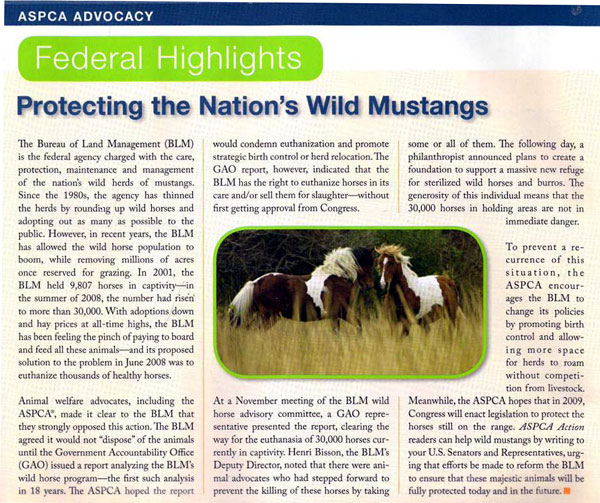
6-9-2010 - Trip out to the Sulphur HMA
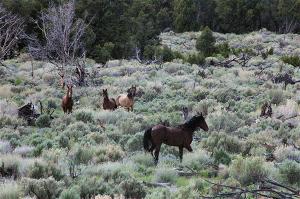
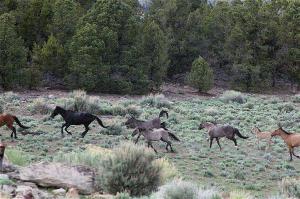
Lower Sulphur Springs Upper Sulphur Springs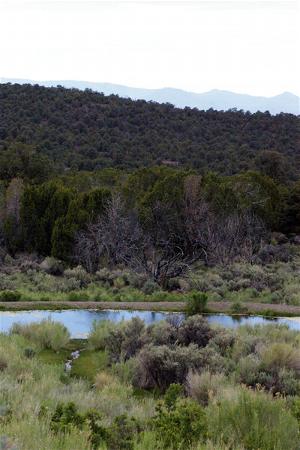
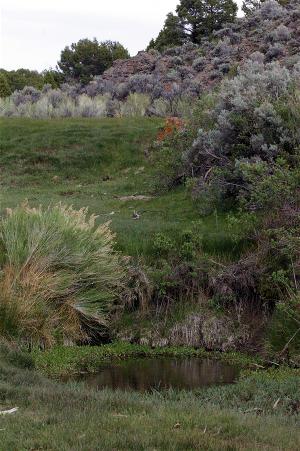
8-1-2011 - The SulphurSprings Horse Registry Inc. was honored by The American Indian Horse Registry with a "Keeper of the Flame" certificate for our dedication to the Sulphur horses a breed descended from the old Spanish horses brought over to the New World by the Conquistadors.....
Thank you AIHR for your honorable Recognition!!!
